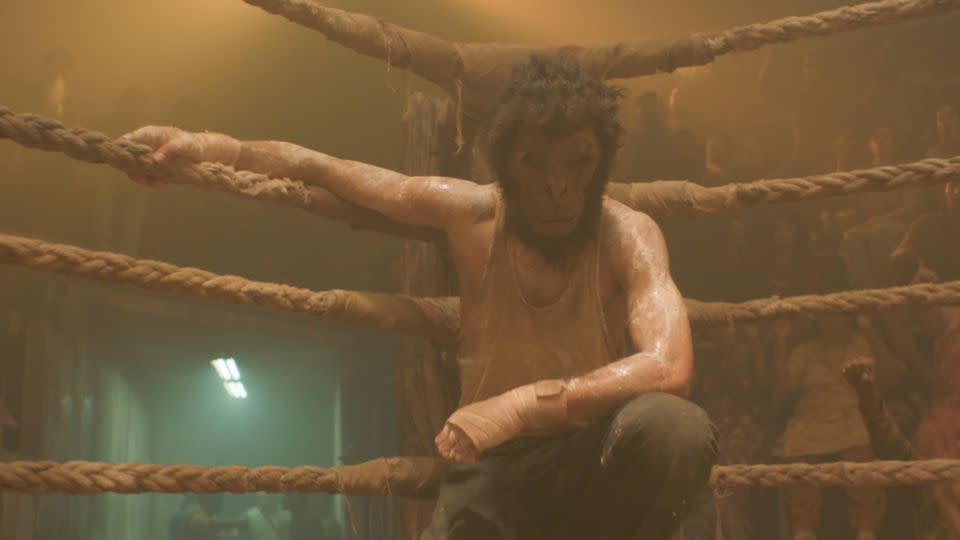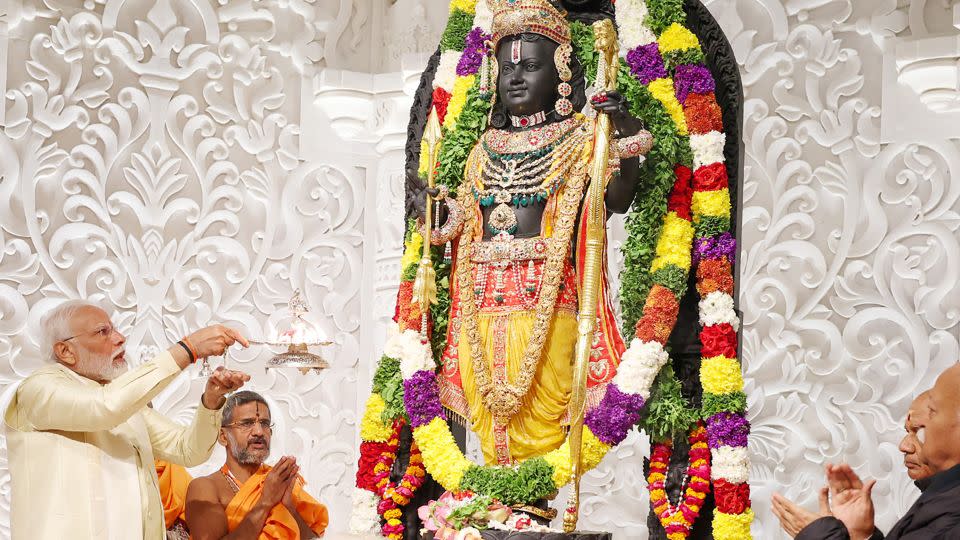How ‘Monkey Man’ offers another vision of Hinduism
- Oops!Something went wrong.Please try again later.
- Oops!Something went wrong.Please try again later.
- Oops!Something went wrong.Please try again later.
“Monkey Man,” Dev Patel’s directorial debut action thriller that he also stars in, wrote and produced, opens with a tale familiar to Hindus around the world.
A child listens as his mother tells him the story of Hanuman, the anthropomorphic monkey god. In his hunger, young Hanuman mistook the sun for a juicy mango. As Hanuman went to take a bite, the gods punished the mischievous deity for overreaching by stripping him of his powers.
This mythology is the foundation of “Monkey Man,” which hit theaters on April 5. Now an adult living in the fictional Indian city of Yatana, Kid (played by Patel himself ) remembers the legend of Hanuman and uses it as inspiration as he plots revenge on the corrupt forces that raided his forest village and killed his mother.
An underdog in a society divided by caste and class, Kid mirrors the simian god in more ways than one. Meanwhile, the film’s villains — as movie critics have noted and as Patel has alluded to — look a lot like India’s right-wing, Hindu nationalist government. In recent years, party leaders have taken actions that critics say marginalize minorities and embolden extremist groups.
“Really, it’s a revenge film about faith and how faith can be a beautiful teacher,” Patel said in a conversation at SXSW. “But at the same time, faith can be weaponized. Faith can be monetized. And you see that in the opposing end.”
By invoking Hanuman — one of the most beloved Hindu deities — in a critique of Hindu nationalism, some critics and viewers say “Monkey Man” does something novel.
It attempts to reclaim Hinduism from those who fan the flames of division, presenting another vision of what the religion stands for.
‘Monkey Man’ is a twist on a classic Hindu tale
“Monkey Man” is stuffed with references to the ancient Hindu epic the “Ramayana,” which includes the story of Hanuman.
Like young Hanuman, whose story we hear in the film’s opening scenes, Kid is initially reckless in his fearlessness even as he pursues a just cause. Patel said in an interview at SXSW that he wanted to use that story as a social commentary on caste and inequality in India.
“When you put those [mythologies] into context of the caste system and the idea of the 1% against the elite or being scolded for reaching too high or aspiring too big, I was like, … ‘I can distill it down and give it some real social weight,’” he said.

In the film, Kid dons a monkey mask and earns his living as a fighter at an underground boxing club. But his true aim is to avenge the death of his mother: When Kid was a child, he and his community of forest-dwellers were forced out of their homes by the police chief Rana Singh (Sikandar Kher), who was acting on behalf of the spiritual leader Baba Shakti (Makarand Deshpande).
Kid eventually gets to Rana by infiltrating a luxury brothel called Kings, where he also encounters a sex worker named Sita (Sobhita Dhulipala) who is trapped in a seemingly hopeless situation. The sequence is a clear parallel to a story in the “Ramayana,” in which Hanuman helps the god Rama rescue his wife Sita from the ten-headed demon king Ravana.
For some viewers, the aspects of Hanuman that weren’t included are just as notable as the aspects that were.
Hanuman is perhaps best known for being a devoted servant of Lord Rama who, in turn, is known for his adherence to the path of righteousness. But in the fictionalized India depicted in “Monkey Man,” there isn’t an analogue for the god Rama, says Sailaja Krishnamurti, an associate professor of gender studies at Queen’s University. Instead, Kid inhabits a world without a clear moral center.
“To take Rama out — to say ‘What’s left when there is no hero deity?’ — (suggests) that we have to become our own heroes,” Krishnamurti said. “I think it’s a really intriguing premise.”
Whether or not Patel’s decision to omit Rama was intentional, Thrisha Mohan, operations and events manager for the group Hindus for Human Rights, found the deity’s absence striking for another reason: In recent years, Rama has been a key feature of Hindu nationalist rhetoric.

In January, Indian Prime Minister Narendra Modi inaugurated a Hindu temple at the site of a 16th century mosque that was demolished by Hindu hardliners in 1992. The temple, named the Ram Janmabhoomi Mandir, is believed by some Hindus to be the birthplace of Lord Rama, and was a cornerstone of Modi’s right-wing Hindu nationalist agenda. For India’s Muslims, however, the temple was another sign of religious divisions that have become more pronounced under Modi’s rule.
“In my mind, a lot of contemporary narratives of Rama are one-and-one associated with Hindu nationalism,” Mohan said. “So to erase that aspect of Hanuman’s character in order to tell a broader story is really interesting.”
The film takes aim at extremist forces
As “Monkey Man” tells a quintessentially Hindu story, it also makes thinly veiled references to Modi’s Bharatiya Janata Party (BJP) and India’s wider political landscape.
“If there is an allegory to be made, it’s clear that the many heads of Ravana are the police chief and the politician and Baba Shakti — the triumvirate of politicized Hindu nationalism,” said Krishnamurti.
As Krishnamurti and Mohan see it, the villains are amalgamations of various leaders and figures in the Hindu nationalist scene. The fictitious Baba Shakti calls to mind right-wing spiritual advisers and politicians in India. Rana, the chief of police, could be seen as a stand-in for bureaucrats and administrators who critics accuse of emboldening extremists and stoking sectarian violence.

“Monkey Man” even briefly incorporates footage from real-life protests against the policies of the Modi administration, though it’s never explicitly addressed in the film.
For others, Patel’s critique of Hindu nationalism wasn’t entirely successful.
Siddhant Adlakha, who reviewed “Monkey Man” for TIME, said he took issue with how the film rooted Kid’s violent rampage against the elites in Hindu imagery — to him, it fell into the same trap as Hindu nationalists who use the faith to justify violence. He also didn’t think the film effectively conveyed the political ideology driving the villains’ greed and corruption.
“It also ends up stripping away the Hindutva (a political ideology that seeks to make India a Hindu nation) villains of a lot of the specifics that would then align them with real world Hindutva,” Adlakha told CNN. “It’s more like he’s battling these vague echoes of Hindutva using Hinduism as a central philosophy that is then imbued with violence.”
He continued, “His character ends up embodying all the things that Patel the filmmaker is trying to fight in the real world.”
But in Krishnamurti’s view, the hero’s violence mimics the violent nature of many stories in Hindu mythology. It’s also a nod to movie genres and stars from which Patel takes inspiration: Amitabh Bachhan in Bollywood, Bruce Lee and Jackie Chan in Hong Kong cinema and Keanu Reeves in Hollywood’s “John Wick” franchise.
It presents a loving vision of Hinduism
Perhaps what is most powerful about “Monkey Man” is how it offers a vision of Hinduism that is inclusive and welcoming, Mohan said.
Kid is a champion of India’s underclasses, and the film contains numerous references to the country’s marginalized communities. When Baba Shakti and Rana overtake Kid’s community of forest-dwellers, it’s an allusion to how Adivasis (the Indigenous peoples of India) and Muslims have been evicted from their lands under Modi’s rule. Another key scene recalls the myth of Ekalavya from the Hindu epic “Mahabharata” — a parable about caste discrimination in which a forest dweller is made to cut off his thumb because his archery skills posed a threat to a prince.
“He’s refusing very one-note narratives that have come out of the way that Hindutva has framed what Hinduism is and who it should be practiced by and who it loves and who it doesn’t,” Mohan said.

“Monkey Man” is also notable for its portrayal of hijras, India’s third-gender community who consider themselves neither male nor female, said Krishnamurti. While hijras are typically depicted in Western media as sex workers, this film casts them as allies and warriors. When Kid bungles his first attack on the nightclub and is shot by the police, he’s rescued by Alpha, the leader of a hijra community that is under threat from Baba Shakti’s political movement.
“What I found really powerful was that if we have a landscape in which there’s no Rama, in which Hanuman is on his own in the form of Kid, the place he finds respite and finds care is in the temple of the hijras,” Krishnamurti said.
Alpha tells Kid about Ardhanarishvara, a deity combining the god Shiva and his consort, the goddess Parvati, to represent masculine and feminine energies in harmony. It’s a powerful image for queer and trans people who have been battling the patriarchal power structures of Hindu nationalism, Krishnamurti said. Alpha and the other hijras in the community are also pivotal to the film’s final battle scene.
While “Monkey Man” has a lot to say about Hinduism and Hindu nationalism, there’s a more universal message at its core, said Bedatri D. Choudhury, the arts and entertainment editor for The Philadelphia Inquirer.
The tensions that the film presents — between Hindus and non-Hindus, rich and poor, those who use religion for just ends or violent ends — aren’t unique to Hinduism, but are present in societies around the world. “Monkey Man,” then, is a warning about what can happen when people are oppressed and disempowered for too long.
“In its own imperfect ways, it is trying to criticize — if not directly the Indian government — the kind of society that takes shape when religion and government become one,” she said.
For more CNN news and newsletters create an account at CNN.com

